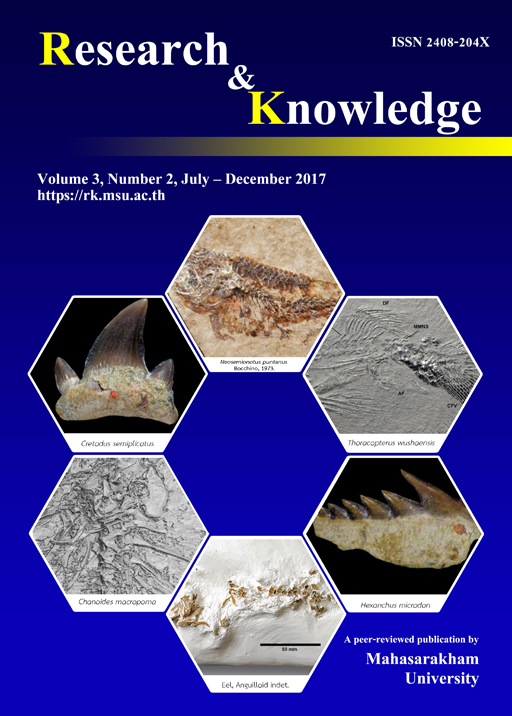Coelacanths from the Middle Triassic of Switzerland and the pace of actinistian evolution
Keywords:
Sarcopterygii, Mesozoic, Europe, morphology, phylogenyAbstract
Latimeria chalumnae (Actinistia) was regarded as the ‘ancestor of the four-legged vertebrates’ and rapidly became the iconic example of a ‘living fossil’. Although its evolutionary position close to the origin of tetrapods is now dismissed, the question of its evolutionary pace is still a matter of debate. The UNESCOs’ World Heritage Monte San Giorgio Triassic site, spanning the border between Italy and Switzerland in the Southern Alps, has yielded one of the major marine vertebrate assemblages of the Middle Triassic worldwide. This general overview of the Middle Triassic coelacanths from Switzerland heralds a project that will be conducted in the following years. The project consists firstly to prepare, describe and compare the coelacanth material from the Besano Formation housed in the collection of the University of Zurich.
References
Alessandri, D. De. 1910. Studii sui pesci triasici della Lombardia. Memorie della Società Italiana di Scienze Naturali e del Museo Civico di Storia Naturale di Milano 7, 1-145.
Bassani, F. 1895. La ittiofauna della Dolomia Principale di Giffoni. Palaeontographia italica 1, 169-210.
Bellotti, C. 1857. Descrizione di alcune nuove specie di pesci fossili di Perledo e d’altre località Lombarde. In: Stoppani, A. Studii geologici e paleontologici sulla Lombardia, Carlo Turati, Milano. pp. 419-438.
Berra, T. M. 1997. Some 20th century fish discoveries. Environmental Biology of Fishes 50, 1-12.
Casane, D. and Laurenti, P. 2013. Why coelacanths are not ‘living fossils’: a review of molecular and morphological data. Bioessays 35, 332-338.
Cavin, L. and Guinot, G. 2014. Coelacanths as “almost living fossils”. Frontiers in Ecology and Evolution 2.
Cavin, L., Furrer, H. and Obrist, C. 2013. New coelacanth material from the Middle Triassic of eastern Switzerland, and comments on the taxic diversity of actinistans. Swiss Journal of Geosciences 106, 161-177.
Cloutier, R. 1991. Patterns, trends, and rates of evolution within the Actinistia. Environmental Biology of Fishes 32, 23–58.
Costa, O. G. 1862. Studii sopra i terreni ad ittioliti del Regno di Napoli diretti a stabilire l’età geologica dei medesimi. Appendice Agli Atti Real Accadeimia delle Scienze, Napoli 12, 1-44.
Dutel, H., Maisey, J. G., Schwimmer, D. R., Janvier, P., Herbin, M. and Clément, G. 2012. The Giant Cretaceous Coelacanth (Actinistia, Sarcopterygii) Megalocoelacanthus dobiei Schwimmer, Stewart & Williams, 1994, and its Bearing on Latimerioidei Interrelationships. PLoSONE 7, e49911.
Forey, P. L. 1998. History of the Coelacanth Fishes. Chapman and Hall, London. Friedman, M. and Coates, M. I. 2006. A new recognized fossil coelacanth highlights the early morphological diversification of the clade. Proceedings of the Royal Society, Series B 273, 245-250.
Furrer, H. and Vandelli, A. 2014. Guide to the Museum of fossils from Monte San Giorgio Meride. Fondazione del Monte San Giorgio, pp.128.
Furrer, H. 2003. Der Monte San Giorgio im Südtessin-vom Berg der Saurier zur Fossil-Lagerstätte internationaler Bedeutung. Neujahrsblatt der Naturforschenden Gesellschaft Zürich 206, 64 pp.
Furrer, H., Schaltegger, U., Ovtcharova, M. and Meister, P. 2008. U-Pb zircon age of volcanic layers in Middle Triassic platform carbonates of the Austroalpine Silvretta Nappe (Switzerland). Swiss Journal of Geosciences 101, 595-603.
Kner, R. 1866. Die Fische der bituminösen Schiefer von Raibl in Kärnthen. Sitzungsberichte der kaiserlichen Akademie der Wissenschaften 53, 1-46.
López-Arbarello, A., Bürgin, T., Furrer, H. and Stockar, R. 2016. New holostean fishes (Actinopterygii: Neopterygii) from the Middle Triassic of the Monte San Giorgio (Canton Ticino, Switzerland). PeerJ 4, e2234.
Mutter, R. J. 2002. Revision of the Triassic Family Colobodontidae sensu Andersson 1916 (emended) with a Tentative Assessment of Perleidiform Interrelationships (Actinopterygii: Perleidiformes). Dissertation Universität Zürich, Switzerland, pp. 355.
Ørvig, T. 1977. A survey of odontodes (‘dermal teeth’) from developmental, structural, functional, and phyletic points of view In: Andrews, S. M., Miles, R. S., Walker, A. D. (Eds.), Problems in Vertebrate Evolution. Academis Press, London, pp. 53-75.
Rieppel, O. 1980. A new coelacanth from the Middle Triassic of Monte San Giorgio, Switzerland. Eclogae Geologicae Helvetiae 73, 921-939.
Rieppel, O. 1985. A second actinistian from the Middle Triassic of Monte San Giorgio, Kt. Tessin, Switzerland. Eclogae Geologicae Helvetiae 78, 707-713.
Schaeffer, B. 1952. Rates of evolution in the coelacanth and dipnoan fishes. Evolution 6, 101-111. Schultze, H. -P. 2004. Mesozoic sarcopterygians. In: Arratia, G., Tintori, A. (Eds.), Mesozoic fishes 3 - systematics, paleoenvironments and biodiverity. Verlag Dr Friedrich Pfeil, München, pp. 463-492.
Stockar, R., Baumgartner, P. O. and Condon, D. 2012. Integrated Ladinian bio-chronostratigraphy and geochrononology of the Monte San Giorgio (Southern Alps, Switzerland). Swiss Journal of Geosciences 105, 85-108.
Teller, F. 1891. Über den Schädel eines fossilen Dipnoers, Ceratodus sturii nov. spec., aus den Schichten der oberen Trias der Nordalpen. Abhandlungen der Kaiserlich - Königlichen Geologischen Reichsanstalt 15, 1-39.
Tintori, A. 2017. 40 years of field work in the Triassic marine vertebrate sites. Research & Knowledge, 3(2), 9-12.
Downloads
Published
How to Cite
Issue
Section
License

This work is licensed under a Creative Commons Attribution-NoDerivatives 4.0 International License.








